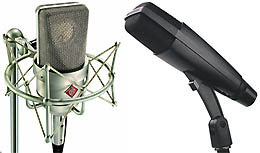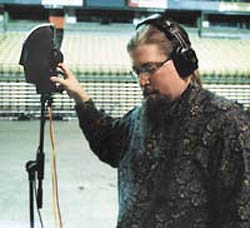Live recording: the double whammy. The crossroads at which sound reinforcement and getting a good clean signal for recording antagonize and compromise each other.
Whether the job is recording a guest speaker at a convention, a discussion panel (any of whom may talk at any moment), coffee house groups, a theatrical presentation, a church service with choir and band, music group in a small venue, or coliseum rock, the first thing you have to decide is exactly what you want to do with what you record, and how good you want it to sound.
A cheap omnidirectional lavalier mic clipped to the talkback microphone gooseneck on your FOH console and a mini disc recorder may be fine for a “quick and dirty” post mortem.
One top-level entertainer I know goes a few steps further and uses stereo head mics positioned at various places in the audience so that after a show he can hear what his audience heard.
In situations like this, you’re just looking for that extra perspective, proving or disproving what you thought happened really did happen. You know, that Twilight Zone head-trip in which you think the mix or performance you just did was great, but upon listening to the recording, you hear some not-so-good things you definitely didn’t hear during the performance.
Dose Of Reality
The phenomenon cuts both ways. At the end of the night, you’re about ready to quit the audio biz and start selling insurance or time-share vacations, because the sound just didn’t come together.
Upon listening, however, you realize that while not perfect, it wasn’t as bad as you thought. Recording live is a great way to add a dose of reality to what you felt was happening during the show.
It’s also a good idea to record every performance, simply to get performers used to the idea that they are being recorded. Recording all the time also increases the chances of capturing those magic moments.
However, when recording live for an important purpose, it’s a different place with different rules to apply (and break).
Maybe you’ve been only moderately happy with your sound, or perhaps a project requires new microphones to get the desired sound. Likely you’ve been in a studio and have heard how much better condenser mics capture the high end: brighter and clearer. Dynamic mics aren’t used all that often for cutting vocal tracks in the studio.
Perhaps you’ve taken notice of big condenser mics just like the ones in the studio, but costing a lot less. Half a dozen of them in the right places could really improve things, right? Not necessarily.
And while I’m thinking about it…WARNING! Don’t ever do mic experiments with a live audience! Only experiment during soundcheck. It’s a fact known by most, but I’m simply covering my butt, pointing it out for those to whom this idea may not yet have occurred.
The six most important reasons NOT to experiment include the mics, the preamps, the PA, the monitors, the performers and the amps.
Enough Distortion
Some of the less expensive condenser mics available are very “edgy” and/or “peaky” – don’t confuse bright with edge or peak.
These new mics may merely sound bright to you at first listen, but over time, you’ll hear the distorted edge. Try them on a guitar amp that already has enough distortion to mask the edginess of the mic itself, but keep them away from vocals.
You also have to consider mic sensitivity levels and sound pressure level (SPL) handling capabilities.
Some condenser mics can’t handle high SPL; either their diaphragms bottom out or the electronics overload, or both. Padding the mic preamp on the console doesn’t help if the mic is distorting.

For example, the sensitivity of a Sennheiser 421 dynamic mic is 2 millivolts/Pascal, while a Neumann TLM 103 condenser mic has a much higher sensitivity at 21 millivolts/ Pascal. The SPL rating for the Sennheiser 421 is 175 dB, while for the TLM 103, it’s 138 dB at .5 percent distortion.
Some console preamps will have difficulty with a mic as hot as a TLM 103, which is capable of a dynamic output voltage of 13 dBu, especially when it’s jammed up against a cranking guitar amp. So as long as the amp isn’t generating over 138 dB SPL, the only level problem might be overloading the mic preamp.
Some condenser and dynamic mics have +5 dB peaks or more in the upper ranges of their frequency responses.
Also be aware that some may have strange off-axis frequency response and phase response anomalies. Sounds that come in from the sides, like mic sharing vocals, amp and monitor wash can dirty up your mix.
Putting these mics on quirky sources with their own peaks is a recipe for pain.




















